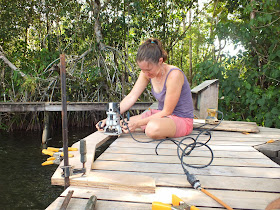It all started with the model that we made whilst still in Texas and a bevel gauge. We copied out the angles from the model on to the transom and on to the central frame. All we had to do then was join them, with a strip of holly used to give a pleasing curve we marked on the shape of the dinghy. Took a step back, when not happy we scribbled out the line and re-drew. We used a very simple design method throughout the dinghy construction. If it looks right; it is.
Of course one absolute necessity for the nesting dinghy is for it to nest. For this, though you mightn't need the whole dinghy, you do need both the joining frames. Knowing that we would run out of wood we cobbled these together from offcuts. Obviously they need to be the same. Ruth used the router to perfectly copy the first frame when making the second frame. A lot of effort then went in to not gluing the second frame to the rest of the dinghy when gluing up. Look carefully for the tape.
Cable
ties worked well as a quick and efficient tie. Though we needed extra
strength for the bow when we resorted to wire and rope due to the
tight angles. The bow itself required a bit of recutting as we
thought it might. Though we had the model to copy, the limitations
that bringing five separate sheets of ply together present along with
the usual, 'oh just a little bit more curve don't you think,'
resulted in needing final adjustment.
Our biggest mistake was not bolting the bow section to the aft section when we glued up the bow section, which is why it didn't fit! Still its amazing what fury can be vented with a hand saw, by the lunch of the day we realised our mistake, we were ready to glue it back up again. The rain clouds being the only dampener of our further progress.
Any excess wood was trimmed off with a plane. The outside edges were rounded so fibreglass could be draped over them easily. The inside corners were filleted and then glassed. Before long the only thing preventing us from having a celebratory paddle, before painting, was the addition of a daggerboard housing, to stop up the gaping hole in the sole. Once complete, who could resist having a little paddle? We were both delighted with the result. Certainly a lot more sprightly than our usual mode of transport the Avon Redcrest.
With
a lick of paint still drying we loaded her on top of the boat as we
went to provision Impetuous before leaving Guatemala. We went wood
shopping again, this time in Rio Dulce, to ensure we would have
enough ply to add the buoyancy tanks and bought some softwood chunks
for the all important mast, gaff and boom. Perhaps not first
quality, but the wood was incredibly cheap and we were able to route
through their piles in order to find the lightest and straightest.
We'll let you know how we get on in time.









Looks pretty good
ReplyDelete